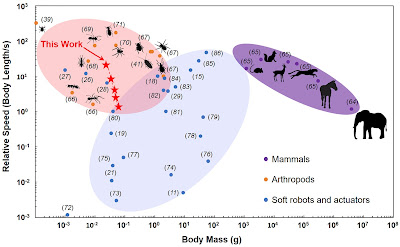Soft robots are getting more and more popular for some very good reasons. Their relative simplicity is one. Their relative low cost is another. And for their simplicity and low cost, they’re generally able to perform very impressively, leveraging the unique features inherent to their design and construction to move themselves and interact with their environment. The other significant reason why soft robots are so appealing is that they’re durable. Without the constraints of rigid parts, they can withstand the sort of abuse that would make any roboticist cringe.
In the current issue of Science Robotics, a group of researchers from Tsinghua University in China and University of California, Berkeley, present a new kind of soft robot that’s both higher performance and much more robust than just about anything we’ve seen before. The deceptively simple robot looks like a bent strip of paper, but it’s able to move at 20 body lengths per second and survive being stomped on by a human wearing tennis shoes. Take that, cockroaches. (...)
To put the robot’s top speed of 20 body lengths per second in perspective, have a look at this nifty chart, which shows where other animals relative running speeds of some animals and robots versus body mass:
This chart shows the relative running speeds of some mammals (purple area), arthropods (orange area), and soft robots (blue area) versus body mass. For both mammals and arthropods, relative speeds show a strong negative scaling law with respect to the body mass: speeds increase as body masses decrease. However, for soft robots, the relationship appears to be the opposite: speeds decrease as the body mass decrease. For the little soft robots created by the researchers from Tsinghua University and UC Berkeley (red stars), the scaling law is similar to that of living animals: Higher speed was attained as the body mass decreased.
If you were wondering, like we were, just what that number 39 is on that chart (top left corner), it’s a species of tiny mite that was discovered underneath a rock in California in 1916. The mite is just under 1 mm in size, but it can run at 0.8 kilometer per hour, which is 322 body lengths per second, making it by far (like, by a factor of two at least) the fastest land animal on Earth relative to size. If a human was to run that fast relative to our size, we’d be traveling at a little bit over 2,000 kilometers per hour. It’s not a coincidence that pretty much everything in the upper left of the chart is an insect—speed scales favorably with decreasing mass, since actuators have a proportionally larger effect. (...)
The researchers also put together a prototype with two legs instead of one, which was able to demonstrate a potentially faster galloping gait by spending more time in the air. They suggest that robots like these could be used for “environmental exploration, structural inspection, information reconnaissance, and disaster relief,” which are the sorts of things that you suggest that your robot could be used for when you really have no idea what it could be used for.
by Evan Ackerman, IEEE Spectrum | Read more:
Image: Science Robotics
Image: Science Robotics
[ed. Because the world needs a better cockroach.]

